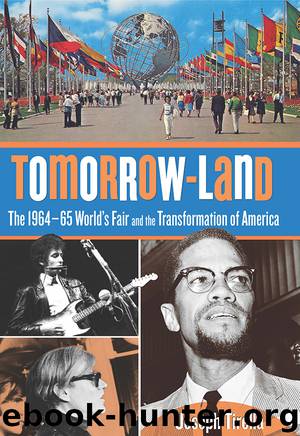Tomorrow-Land by Joseph Tirella

Author:Joseph Tirella
Language: eng
Format: epub
Publisher: Lyons Press
Published: 2014-01-07T05:00:00+00:00
22.
The 1939 fair was a promise. The 1964 fair is a boast. . . . And somehow, in its jostling, heedless, undisciplined energy, it makes a person happy to be alive in the 20th century.
—Time, June 5, 1964
Shortly before the World’s Fair opened, Robert Moses and a reporter from the Saturday Evening Post, then one of the nation’s most popular magazines, stood on top of one of the Fair’s tallest buildings. The Master Builder, obviously pleased with himself and his handiwork, looked around, surveying the mesmerizingly diverse assortment of pavilions and space-age structures that now stood erect in Flushing Meadow Park—which, as he reminded many a journalist, he had created after clearing the soiled wetlands of the debris and garbage of Brooklyn. Then he spoon-fed his interviewer the article’s opening. “Well, I guess they’ll just have to say, ‘The old SOB did it again,’” he said.
Despite the relentless hyperbole emanating from Flushing Meadow (“the single greatest event in history!”), few would dispute that Moses had essentially delivered on his promise to create a World’s Fair that had “something for everyone.” From Michelangelo’s Renaissance masterpiece La Pietà to the Walt Disney Audio-Animatronics that brought the past to life—Jurassic age dinosaurs, wheel-building cavemen, and the slain sixteenth US president, Abraham Lincoln, the last of which was so lifelike that when it stood up to speak, one shocked five-year-old shouted, “But Daddy, I thought you said he was dead!”—to introducing the latest in consumer products, including color television, the Picturephone (preceding Skype by almost fifty years), and an IBM computer, something few people had ever seen up close before, the past and the future could be seen at the Fair. And right from the start the Fair seemed to be on solid financial ground: The exhibition had sold $35 million in advance tickets, making many New York officials involved with the project—Moses in particular—wonder if their stated goal of seventy million visitors was too low.
There was much to choose from at the Fair. Despite the earlier outcry of critics, there was plenty of art representing several centuries and an impressive variety of styles: the aforementioned Michelangelo; Spanish old masters like Goya, Velázquez, and El Greco; modernist icons like Picasso, Miró, and Matisse; the landscape romanticism of the Hudson River School painters (which fittingly decorated the interior of the New York State Pavilion); a healthy sampling of the abstract expressionists; as well as the pop art stylings of Robert Rauschenberg, Roy Lichtenstein, and John Chamberlain, whose work—preoccupied with consumer culture as it was—seemed right at home among the Fair’s corporate pavilions.
There were nearly seventy foreign nations (eighty including municipalities like West Berlin and city-states like the Vatican) that truly represented the world—not just the West. With most of the major European nations, including America’s key NATO allies (the United Kingdom, France, Italy, West Germany), sitting out, as well as its Cold War antagonists staying home (the USSR and its Warsaw Pact puppet states of Central and Eastern Europe), and other Communist enemies
Download
This site does not store any files on its server. We only index and link to content provided by other sites. Please contact the content providers to delete copyright contents if any and email us, we'll remove relevant links or contents immediately.
| Africa | Americas |
| Arctic & Antarctica | Asia |
| Australia & Oceania | Europe |
| Middle East | Russia |
| United States | World |
| Ancient Civilizations | Military |
| Historical Study & Educational Resources |
Cat's cradle by Kurt Vonnegut(15101)
Pimp by Iceberg Slim(14219)
4 3 2 1: A Novel by Paul Auster(12221)
Underground: A Human History of the Worlds Beneath Our Feet by Will Hunt(11981)
The Radium Girls by Kate Moore(11867)
Wiseguy by Nicholas Pileggi(5609)
Perfect Rhythm by Jae(5277)
American History Stories, Volume III (Yesterday's Classics) by Pratt Mara L(5212)
The Fire Next Time by James Baldwin(5200)
Paper Towns by Green John(5024)
Pale Blue Dot by Carl Sagan(4858)
A Higher Loyalty: Truth, Lies, and Leadership by James Comey(4797)
The Mayflower and the Pilgrims' New World by Nathaniel Philbrick(4377)
The Doomsday Machine by Daniel Ellsberg(4375)
Killers of the Flower Moon: The Osage Murders and the Birth of the FBI by David Grann(4348)
The Sympathizer by Viet Thanh Nguyen(4262)
Too Much and Not the Mood by Durga Chew-Bose(4228)
The Borden Murders by Sarah Miller(4186)
Sticky Fingers by Joe Hagan(4064)
